Polymers for Cell-based Therapies
Cell-based therapies represent a new approach to treating chronic endocrine disorders including Diabetes and lysosomal storage disorders and many others. These therapies can involve transplanting cells that can provide the missing enzymes or hormones. Our research is aimed at developing synthetic extracellular matrices (ECM) to enable these therapies as well as related but more fundamental stem cell studies.
This work is supported through a variety of funding, including a recent NSERC CREATE Award for Integrated Development of Extracellular Matrices (IDEM). The research in my own group, in particular, aims at development of:
1. Immuno-isolating polymer capsules to protect transplanted therapeutic cells from the patients' immune system.
Cell encapsulation within semipermeable hydrogel capsules provides the mechanical protection and immuno-isolation needed for the survival of non-autologous therapeutic cells capable of expressing e.g. insulin and certain enzymes missing in a patient.
We pioneered the use of reactive polyanions / polycation pairs to form covalently crosslinked shells around primary, cell-containing beads. The resulting shells show advantages over conventional APA capsules, and may permit long-term immuno-protection of transplanted cells.
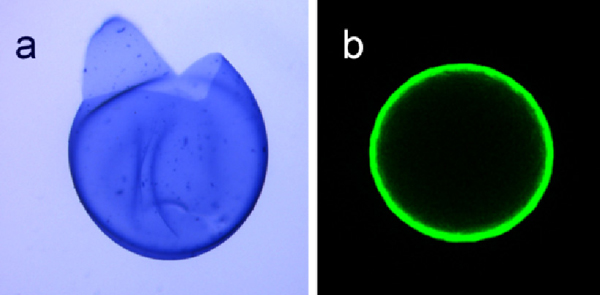
We are currently carrying out tests of these capsules with C2C12 mouse and Min 6 cells. The images on the right are of cell-free model capsules. Trypan Blue staining (a) and confocal laser fluorescent microscopy (b) are used to visualize and study the thickness of the crosslinked shells (capsule diameters are approximately 500 micrometer).
2. Polymeric extracellular matrices (ECM) that can serve as platforms for the study of stem cell behavior.
We are developing synthetic hydrophilic polymers that may serve as defined extracellular matrices for different types of cell studies. This program involves both conformal coating of individual cells with thin shells of semipermeable crosslinked polymers, as well as development of thin films suitable as supports for cell biology.
Functional Polymers and Capsules
We have significant experience in developing responsive polymers, and novel composite polymer colloids
3. Thermally Responsive Polymers
Certain polymers such as poly-(N-isopropylacrylamide), pNIPAM, are soluble in cold water but precipitate upon warming to 32°C. This counter-intuitive behaviour, called a cloud point, is caused by an entropy-driven dissociation of water from the polymer upon warming. The cloud point temperature varies with composition, and the resulting thermally switchable materials are of interest for drug delivery systems.
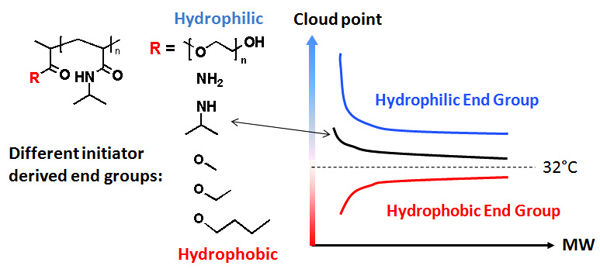 We have pioneered the copper-catalyzed controlled radical polymerization of NIPAM and similar acrylamide monomers, and showed interesting effects of molecular weight and initiator-derived endgroups on cloud point behaviour of pNIPAM.
We have pioneered the copper-catalyzed controlled radical polymerization of NIPAM and similar acrylamide monomers, and showed interesting effects of molecular weight and initiator-derived endgroups on cloud point behaviour of pNIPAM.
We demonstrated that copolymers of dimethylacrylamide and glycidylmethacrylate show cloud points that are tuneable through copolymer composition, and that these polymers can be crosslinked to form gel spheres.
We recently found that certain copolymers show additional, insoluble-to-soluble phase transition at higher temperatues, related to an upper critical solution temperature. This property is attributed to breaking of hydrogen-bonds between polymer chains.
We are interested in exploring the use of these thermal phase separations for encapsulations, and formation of hydrogel films.
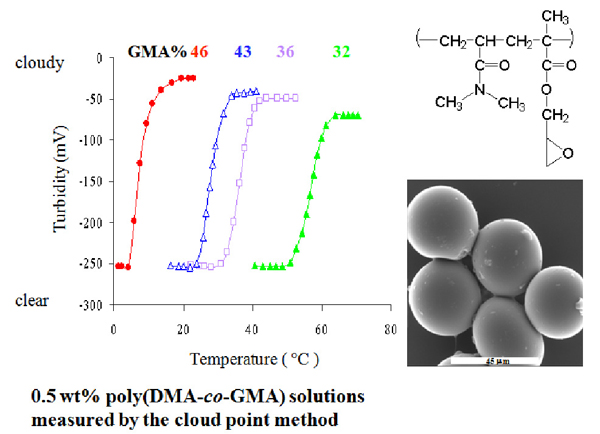
4. Structured Microspheres and Capsules
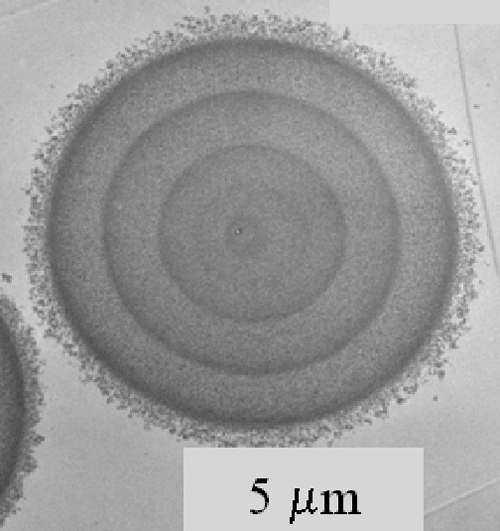 We have discovered that oscillations in temperature during a crosslinking polymerization can, under certain circumstances, be used to inscribe corresponding profiles of crosslink densities into microspheres grown in organic solvents. The TEM image on the right shows an onion-like microsphere consisting of several nested layers of different crosslink density, formed by oscillating the polymerization temperature during their growth by a couple of degrees Centrigrade about the theta-temperature of the forming polymer network, a copolymer of divinylbenzene and chloromethylstyrene. Such structures are of potential interest as optical band gap materials, and as controlled release devices acting by delamination.
We have discovered that oscillations in temperature during a crosslinking polymerization can, under certain circumstances, be used to inscribe corresponding profiles of crosslink densities into microspheres grown in organic solvents. The TEM image on the right shows an onion-like microsphere consisting of several nested layers of different crosslink density, formed by oscillating the polymerization temperature during their growth by a couple of degrees Centrigrade about the theta-temperature of the forming polymer network, a copolymer of divinylbenzene and chloromethylstyrene. Such structures are of potential interest as optical band gap materials, and as controlled release devices acting by delamination.
We developed layered microspheres by sequential precipitation polymerization. The 'onion-type' microspheres shown on the right were formed by adding small aliquots of a reactive comonomer, such as phenylmaleimide, during the radial growth of the polydivinylbenzene base particle. The resulting multi-layer spheres can be further reacted or etched to create hollow inter-layers.
5. Polyurea Capsules formed by Interfacial Polymerization
Polyurea capsules for controlled delivery of agricultural actives are formed by interfacial polycondensation of isocyanates in an organic, dispersed phase, with amines dissolved in the continuous aqueous phase. The resulting polyurea shells help maintain capsule integrity, control both rate and mechanism of release of the active, and may be modified to improve adhesion to foliage. We are exploring ways to assign these orthogonal functions to different wall layers. In the research shown below, Scanning Transmission X-ray Microspectroscopy (STXM) is used to quantitatively map components on the nanometer scale.
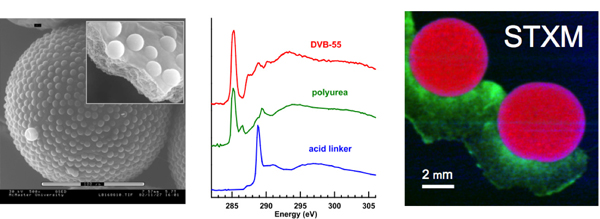 For example, we have incorporated porous poly(divinylbenzene-55) microspheres into otherwise impermeable polyurea capsule walls in order to control release through the surface density of microspheres, rather than through permability of the capsule wall itself. Conversely, we showed that delaminated clay nano-particles can be used to retard diffusional release of volatile fills.
For example, we have incorporated porous poly(divinylbenzene-55) microspheres into otherwise impermeable polyurea capsule walls in order to control release through the surface density of microspheres, rather than through permability of the capsule wall itself. Conversely, we showed that delaminated clay nano-particles can be used to retard diffusional release of volatile fills.
We showed that mixtures of isocyanates having different reactivities can be used to form multi-layer polyurea walls that might ultimately assume separate roles of structural support and release control. The resulting capsules were reacted with polyelectrolytes to modify the outer surface, to try to influence adhesion behaviour.

